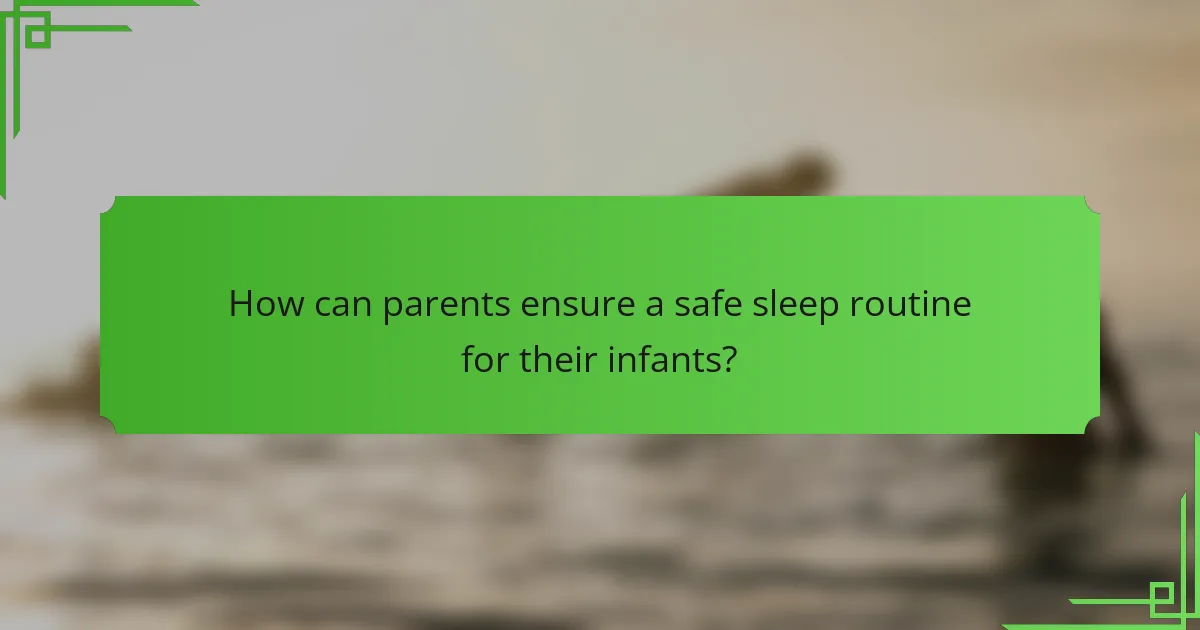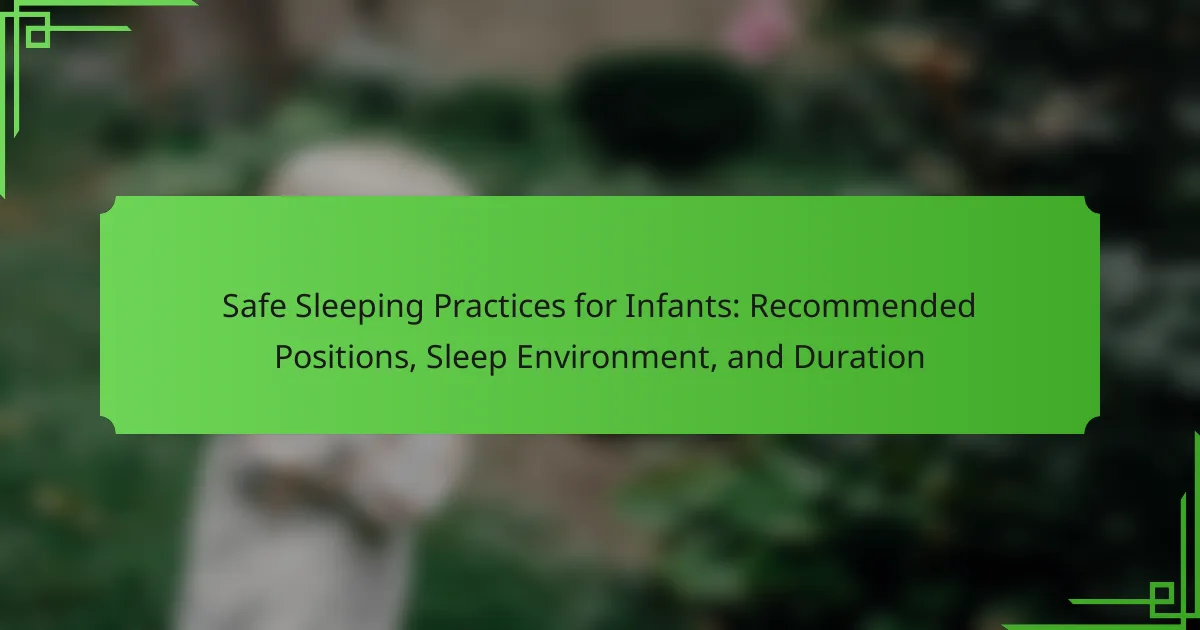Safe sleeping practices for infants are essential for reducing the risk of Sudden Infant Death Syndrome (SIDS) and ensuring a secure sleep environment. Key recommendations include placing infants on their backs to sleep, using a firm and flat mattress without soft bedding or toys, and adhering to safety standards for cribs and bassinets. Room-sharing without bed-sharing is advised for the first six months to facilitate close monitoring, while maintaining a comfortable room temperature helps prevent overheating. Common mistakes, such as placing infants on their stomachs or using soft bedding, should be avoided to enhance safety during sleep. Following these guidelines is crucial for promoting a safe sleep routine for infants.

What are Safe Sleeping Practices for Infants?
Safe sleeping practices for infants include placing them on their backs to sleep. This position significantly reduces the risk of Sudden Infant Death Syndrome (SIDS). The sleep environment should be firm and flat, free from soft bedding, pillows, and toys. Infants should sleep in a crib or bassinet that meets safety standards. Room-sharing without bed-sharing is recommended to keep the infant close while ensuring a safe sleep space. Maintaining a comfortable room temperature helps prevent overheating. Parents should avoid using sleep positioners or other devices that may pose risks. Following these practices can enhance infant safety during sleep.
Why is safe sleep important for infants?
Safe sleep is crucial for infants to reduce the risk of Sudden Infant Death Syndrome (SIDS). SIDS is a leading cause of death in infants under one year old. The American Academy of Pediatrics recommends placing infants on their backs to sleep. This position significantly lowers the chances of SIDS. Additionally, a firm sleep surface is essential. Soft bedding and toys should be avoided in the sleep area. Maintaining a smoke-free environment is also vital for safe sleep. Studies show that these practices can decrease SIDS risk by up to 50%. Safe sleep practices create a secure environment for infants to rest and thrive.
What risks are associated with unsafe sleeping practices?
Unsafe sleeping practices can lead to serious health risks for infants. These risks include Sudden Infant Death Syndrome (SIDS), which is the sudden and unexplained death of an otherwise healthy baby. Research indicates that infants sleeping on their stomachs or sides are at a higher risk for SIDS. Additionally, unsafe sleep environments, such as soft bedding or co-sleeping with adults, increase the likelihood of suffocation. According to the American Academy of Pediatrics, placing infants on their backs to sleep significantly reduces the risk of SIDS. Furthermore, overheating due to excessive clothing or bedding can also be a contributing factor to these risks.
How can safe sleep practices reduce these risks?
Safe sleep practices can significantly reduce the risks of Sudden Infant Death Syndrome (SIDS) and other sleep-related hazards. Placing infants on their backs to sleep is the most effective method to lower the risk of SIDS. This position helps ensure that the airway remains clear. Additionally, using a firm mattress without soft bedding minimizes the chances of suffocation. Keeping the sleep environment free from toys, pillows, and blankets is also crucial. Research shows that infants who sleep in a safe environment are less likely to experience sleep-related incidents. The American Academy of Pediatrics recommends these practices to promote safer sleep for infants.
What are the recommended sleeping positions for infants?
Infants are recommended to sleep on their backs. This position significantly reduces the risk of Sudden Infant Death Syndrome (SIDS). The American Academy of Pediatrics advises this practice. Babies should be placed on a firm mattress without soft bedding. Side sleeping is not recommended as it can lead to rolling onto the stomach. Stomach sleeping should also be avoided due to safety concerns. Parents should ensure the sleep environment is free of toys and loose bedding. Following these guidelines promotes safer sleep for infants.
What is the best sleeping position for infants?
The best sleeping position for infants is on their backs. This position significantly reduces the risk of Sudden Infant Death Syndrome (SIDS). The American Academy of Pediatrics (AAP) recommends back sleeping for all sleep times, including naps. Infants should be placed on a firm mattress with no soft bedding. This practice helps maintain an open airway during sleep. Research shows that infants who sleep on their backs are less likely to experience breathing difficulties. It is essential to continue this practice until the infant is one year old.
Are there any positions to avoid when putting an infant to sleep?
Infants should not be placed to sleep on their stomachs or sides. These positions increase the risk of sudden infant death syndrome (SIDS). The American Academy of Pediatrics recommends placing infants on their backs for all sleep times. This position significantly lowers the chances of SIDS. Additionally, avoid using soft bedding, pillows, or toys in the crib, as these can also pose suffocation hazards. Research shows that back-sleeping is the safest sleep position for infants.
What should an ideal sleep environment for infants include?
An ideal sleep environment for infants should include a firm mattress and a fitted sheet. The crib or bassinet must meet safety standards to prevent accidents. It should be free from soft bedding, pillows, and toys to reduce the risk of suffocation. The room temperature should be maintained between 68 to 72 degrees Fahrenheit for comfort. Adequate ventilation is essential to ensure fresh air circulation. The sleep area should be quiet and dark to promote restful sleep. Infants should be placed on their backs to sleep to minimize the risk of Sudden Infant Death Syndrome (SIDS). These guidelines are supported by the American Academy of Pediatrics (AAP) recommendations for safe sleep practices.
How can temperature affect an infant’s sleep safety?
Temperature significantly affects an infant’s sleep safety. An environment that is too hot can lead to overheating, increasing the risk of sudden infant death syndrome (SIDS). The American Academy of Pediatrics recommends maintaining a room temperature between 68°F and 72°F (20°C to 22°C) for safe sleep. Cold temperatures can also pose risks, as infants may become too chilled, leading to discomfort and disrupted sleep. Proper clothing, such as a sleep sack, can help regulate an infant’s body temperature during sleep. Monitoring the infant’s skin temperature can provide additional safety assurance.
What type of bedding is safest for infants?
The safest type of bedding for infants is a firm mattress covered with a fitted sheet. This setup minimizes the risk of suffocation and Sudden Infant Death Syndrome (SIDS). Soft bedding, such as pillows, blankets, and bumper pads, should be avoided. The American Academy of Pediatrics recommends a bare crib for safe sleep. Infants should sleep on their backs on this firm surface. Research indicates that a firm sleep surface significantly lowers the risk of SIDS.

How can parents ensure a safe sleep routine for their infants?
Parents can ensure a safe sleep routine for their infants by following specific guidelines. Infants should always be placed on their backs to sleep. This position reduces the risk of Sudden Infant Death Syndrome (SIDS). The sleep environment should be free of soft bedding, pillows, and toys. These items can pose suffocation hazards. Parents should use a firm mattress covered with a fitted sheet. The crib or bassinet should meet safety standards set by the Consumer Product Safety Commission. Room sharing without bed sharing is recommended for the first six months. This practice allows parents to monitor their infant closely. Maintaining a comfortable room temperature can also help prevent overheating. Following these practices significantly lowers the risk of sleep-related incidents.
What are the guidelines for the duration of sleep for infants?
Infants typically require 14 to 17 hours of sleep in a 24-hour period. Newborns may sleep up to 18 to 20 hours daily. Sleep duration decreases as infants grow. By six months, most infants need about 14 to 15 hours of sleep. By one year, the requirement drops to 12 to 14 hours. These guidelines are supported by the American Academy of Pediatrics. Adequate sleep is crucial for an infant’s development and health.
How does the age of the infant affect sleep duration recommendations?
The age of the infant significantly affects sleep duration recommendations. Newborns typically require 14 to 17 hours of sleep per day. This amount decreases as infants grow. By six months, recommended sleep duration is about 12 to 15 hours. Toddlers, aged one to two years, generally need 11 to 14 hours of sleep. These recommendations are based on developmental needs. Insufficient sleep can affect an infant’s growth and cognitive development. The American Academy of Pediatrics provides these guidelines to ensure healthy sleep patterns.
What signs indicate that an infant is getting enough sleep?
Signs that indicate an infant is getting enough sleep include consistent alertness during awake periods and a calm demeanor. Infants typically show fewer signs of fussiness and irritation when well-rested. They may also have regular feeding patterns without excessive hunger cues. Additionally, a well-slept infant often displays smooth transitions between sleep cycles. According to the American Academy of Pediatrics, infants should sleep around 14 to 17 hours per day, which supports overall health and development. Observing these signs can help caregivers ensure that the infant is meeting their sleep needs.
What are the best practices for creating a safe sleep environment?
The best practices for creating a safe sleep environment for infants include placing the baby on their back to sleep. This position reduces the risk of Sudden Infant Death Syndrome (SIDS). The sleep surface should be firm and flat, such as a safety-approved crib mattress. Soft bedding, including pillows, blankets, and bumper pads, should be avoided as they can pose suffocation hazards. The crib or bassinet should be free from toys and other items that could obstruct the baby’s breathing. Room-sharing without bed-sharing is recommended, keeping the baby’s sleep area close to the parents. Maintaining a comfortable room temperature helps prevent overheating, which is a risk factor for SIDS. Following these guidelines significantly enhances the safety of an infant’s sleep environment.
How can parents minimize distractions in the sleep area?
Parents can minimize distractions in the sleep area by creating a calm and quiet environment. This includes reducing noise levels by using white noise machines or soft music. Parents should also ensure that the room is dark by using blackout curtains. Keeping the sleep area free from electronic devices is essential, as screens can emit light and disrupt sleep. Additionally, maintaining a comfortable temperature can help promote better sleep. Removing clutter and unnecessary items from the crib or sleep area can further reduce distractions. Studies show that a conducive sleep environment can improve sleep quality for infants.
What role does the crib design play in sleep safety?
Crib design plays a critical role in sleep safety for infants. Proper crib design minimizes the risk of suffocation and injury. Cribs should have slats that are no more than 2 3/8 inches apart to prevent entrapment. The mattress should fit snugly within the crib frame to avoid gaps. Crib height should allow parents to easily place and remove the baby without strain. Additionally, cribs should be free of soft bedding, toys, and bumpers that can pose suffocation hazards. According to the American Academy of Pediatrics, safe sleep environments significantly reduce the risk of Sudden Infant Death Syndrome (SIDS). Thus, appropriate crib design is essential for ensuring infant safety during sleep.

What common mistakes should be avoided in infant sleep practices?
Common mistakes to avoid in infant sleep practices include placing infants on their stomachs to sleep. This position increases the risk of Sudden Infant Death Syndrome (SIDS). Another mistake is using soft bedding or pillows in the crib. Soft surfaces can lead to suffocation hazards for infants. Additionally, co-sleeping with adults can pose risks, as it may lead to accidental suffocation or rolling onto the infant. Parents should also avoid overheating the infant by overdressing or using heavy blankets. Lastly, neglecting to maintain a consistent sleep routine can disrupt an infant’s sleep patterns. Following these guidelines can significantly enhance infant safety during sleep.
What are some misconceptions about infant sleep safety?
One misconception about infant sleep safety is that babies should sleep on their stomachs. This belief stems from outdated practices that have been debunked. Research indicates that placing infants on their backs significantly reduces the risk of Sudden Infant Death Syndrome (SIDS). Another misconception is that soft bedding is safe for infants. In reality, soft pillows, blankets, and crib bumpers can pose suffocation hazards. The American Academy of Pediatrics advises against these items in sleep environments. Some parents also believe that room-sharing without bed-sharing is unsafe. However, studies show that room-sharing can lower SIDS risk when done correctly. Lastly, many think that infants can be swaddled indefinitely. Experts recommend transitioning away from swaddling once the baby shows signs of rolling over.
How can misinformation lead to unsafe sleep practices?
Misinformation can lead to unsafe sleep practices by promoting incorrect guidelines for infant sleep. For example, false claims about the safety of sleep position can encourage placing infants on their stomachs. Research indicates that stomach sleeping increases the risk of Sudden Infant Death Syndrome (SIDS). Additionally, misinformation about sleep environment can suggest unsafe bedding or co-sleeping practices. Studies show that soft bedding and parental bed-sharing are associated with higher SIDS rates. When caregivers follow these misleading recommendations, they inadvertently expose infants to greater safety risks. Accurate information is crucial for ensuring safe sleep practices and protecting infant health.
What are the most common errors parents make regarding infant sleep?
Parents commonly make errors regarding infant sleep, including placing infants on their stomachs to sleep. This position increases the risk of sudden infant death syndrome (SIDS). Another frequent mistake is using soft bedding, such as pillows and blankets, which can lead to suffocation hazards. Parents often underestimate the importance of a safe sleep environment, neglecting to keep the crib free of toys and clutter. Additionally, many parents do not follow recommended sleep duration guidelines, which can affect an infant’s development. Lastly, some parents may co-sleep with their infants, posing risks of accidental injury or suffocation. These practices contradict the guidelines set by organizations like the American Academy of Pediatrics, which emphasizes safe sleep practices to reduce risks.
What practical tips can help ensure safe sleep for infants?
To ensure safe sleep for infants, place them on their backs for every sleep. This position significantly reduces the risk of Sudden Infant Death Syndrome (SIDS). Use a firm mattress in a safety-approved crib. Avoid soft bedding, pillows, and toys in the crib. Keep the sleep environment at a comfortable temperature to prevent overheating. Breastfeeding is recommended as it can lower SIDS risk. Ensure that infants sleep in the same room as caregivers, but not in the same bed. Follow these guidelines consistently to create a safe sleep environment for infants.
How can parents establish a consistent sleep routine for their infants?
Parents can establish a consistent sleep routine for their infants by creating a calming environment and setting regular sleep times. This includes dimming lights and reducing noise before bedtime. Consistency is key; infants thrive on routine. Parents should aim for the same bedtime and wake time each day. They can implement a calming pre-sleep ritual, such as reading or gentle rocking. Research indicates that a predictable routine can improve sleep quality and duration for infants. A study by Mindell et al. (2015) shows that consistent sleep schedules lead to better sleep outcomes.
What resources are available for parents seeking guidance on infant sleep safety?
Resources available for parents seeking guidance on infant sleep safety include the American Academy of Pediatrics (AAP) guidelines. The AAP provides recommendations on safe sleep practices. Their website offers detailed information on sleep environments and safe sleeping positions. The Centers for Disease Control and Prevention (CDC) also provides resources on infant sleep safety. The CDC emphasizes the importance of placing infants on their backs to sleep. Additionally, the National Institute of Child Health and Human Development (NICHD) offers educational materials and research-based guidelines. These resources are designed to help parents create a safe sleep environment for their infants.
Safe sleeping practices for infants are essential to reduce the risk of Sudden Infant Death Syndrome (SIDS) and ensure a secure sleep environment. Key recommendations include placing infants on their backs to sleep, using a firm mattress, and avoiding soft bedding and toys in the crib. The article also discusses the importance of maintaining a comfortable room temperature, room-sharing without bed-sharing, and establishing a consistent sleep routine. Additionally, it highlights common mistakes parents make regarding infant sleep and provides resources for further guidance on safe sleep practices.
